Finding Your Dream Wedding Dress: A Step-by-Step Guide
Finding the Perfect Wedding Dress – A Complete Guide
By: Viva Weddings / Updated on: 13/07/2025
Choosing your wedding dress is one of the most magical parts of planning your big day. But with so many styles, fabrics, and fits out there, it can feel a little overwhelming. Don’t worry — this ultimate guide is designed to walk you through every step of the process. Whether you’re dreaming of a princess ball gown or a sleek, minimalist slip dress, we’ll help you discover what suits your body, your wedding theme, and most importantly — your personality.
Step 1: Understand Wedding Dress Silhouettes
Silhouettes are the foundation of every wedding dress. Understanding the basic shapes helps you narrow down your options and focus on what complements your body best. Let’s take a deep dive into each silhouette and explore why brides fall in love with them.
1. A-Line Wedding Dress: Universally Flattering and Timeless
This classic silhouette is shaped like the letter “A” — a fitted bodice that gently flares out at the waist. The beauty of the A-line is its versatility. It adds shape where needed and creates a beautiful flow, making it perfect for both casual and formal weddings.
Best For: Every body type, especially pear-shaped, plus-size, and petite brides
Ideal Wedding Themes: Garden, vineyard, traditional chapel, beach, and boho weddings
Why Brides Love It: It’s forgiving, flowy, and creates a dreamy romantic look. It’s also extremely comfortable — you can walk, dance, and twirl without feeling restricted.
Extra Tip: Try layered tulle A-line dresses for a softer, ethereal vibe or go with satin for a more structured and modern look.
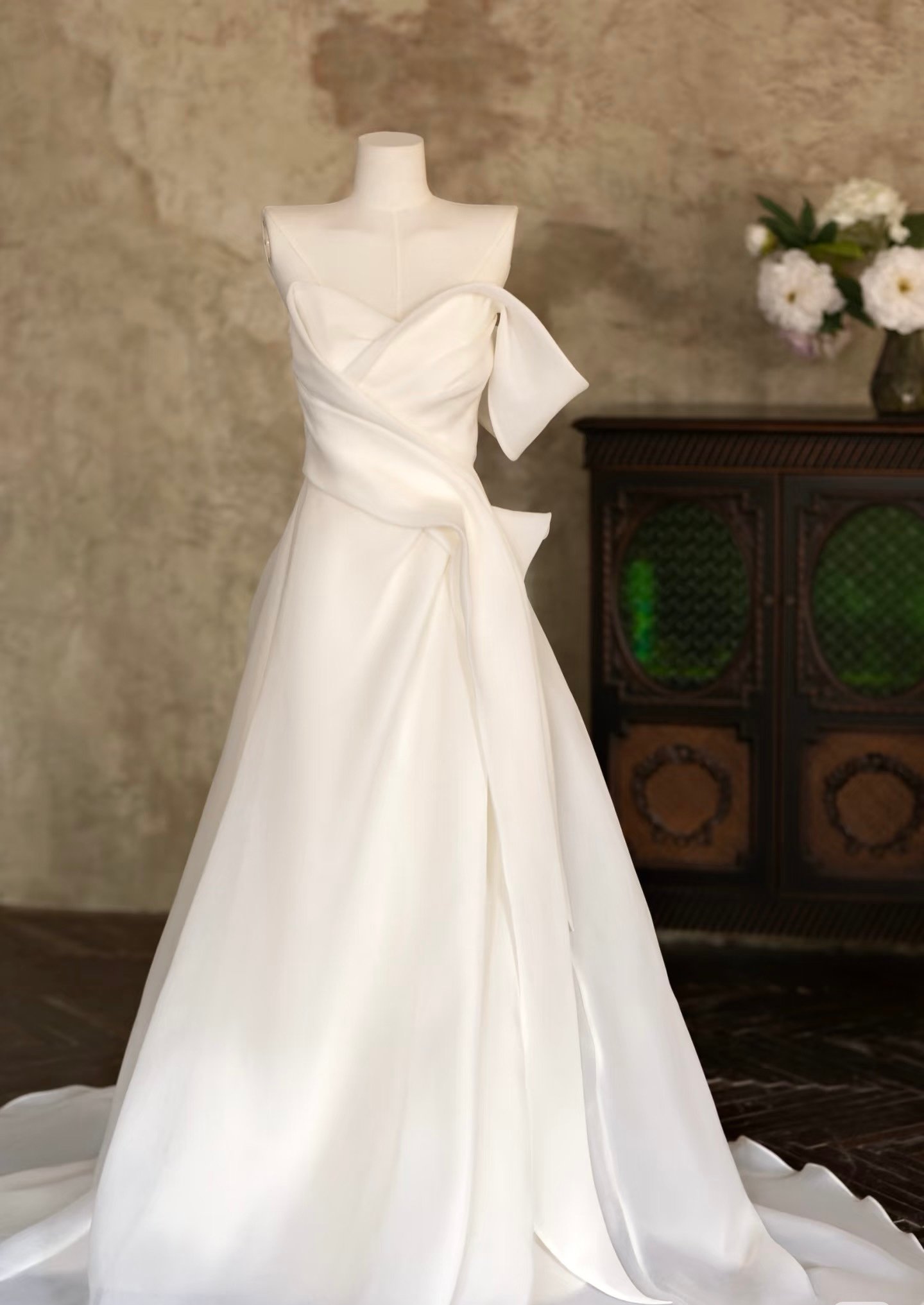
2. Ball Gown: The Ultimate Fairy-Tale Dress
Nothing says “princess” like a dramatic ball gown. With a fitted bodice and a voluminous skirt, this silhouette is designed for maximum impact. It draws attention to the waist and gracefully hides the lower body, making it a go-to for dramatic entrances.
Best For: Hourglass, pear-shaped, or apple-shaped brides
Ideal Wedding Themes: Royal, luxury, black-tie, cathedral, and winter weddings
Why Brides Love It: It’s a statement-maker. Whether you want to feel regal, romantic, or just like a Disney princess, a ball gown delivers.
Extra Tip: Choose structured fabrics like mikado or taffeta for a regal effect, or go soft with layers of organza or tulle for a whimsical fairy-tale feel.
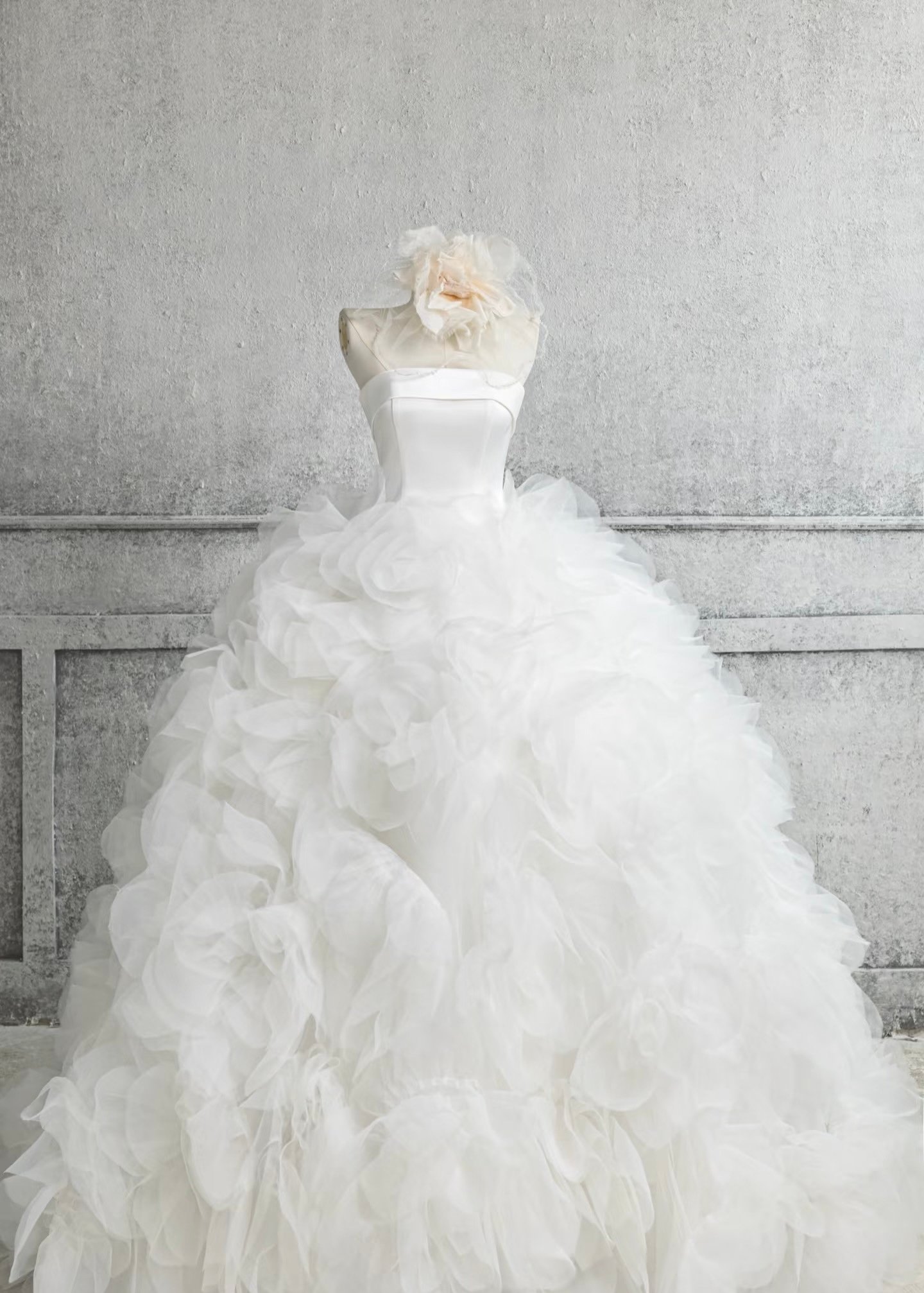
3. Mermaid Wedding Dress: Glamorous and Curve-Hugging
This silhouette hugs tightly from the chest to the knees and flares out at or below the knee, creating a true “mermaid” tail. It’s perfect for brides who want to showcase their curves and feel ultra-glamorous.
Best For: Hourglass and curvy brides confident in their figure
Ideal Wedding Themes: Hollywood glam, evening affairs, or high-end urban weddings
Why Brides Love It: It’s incredibly flattering for curves and creates a bold, feminine shape that turns heads.
Extra Tip: Choose stretchy fabrics like crepe or stretch satin to allow better movement — mermaid dresses can be restrictive if not tailored well.
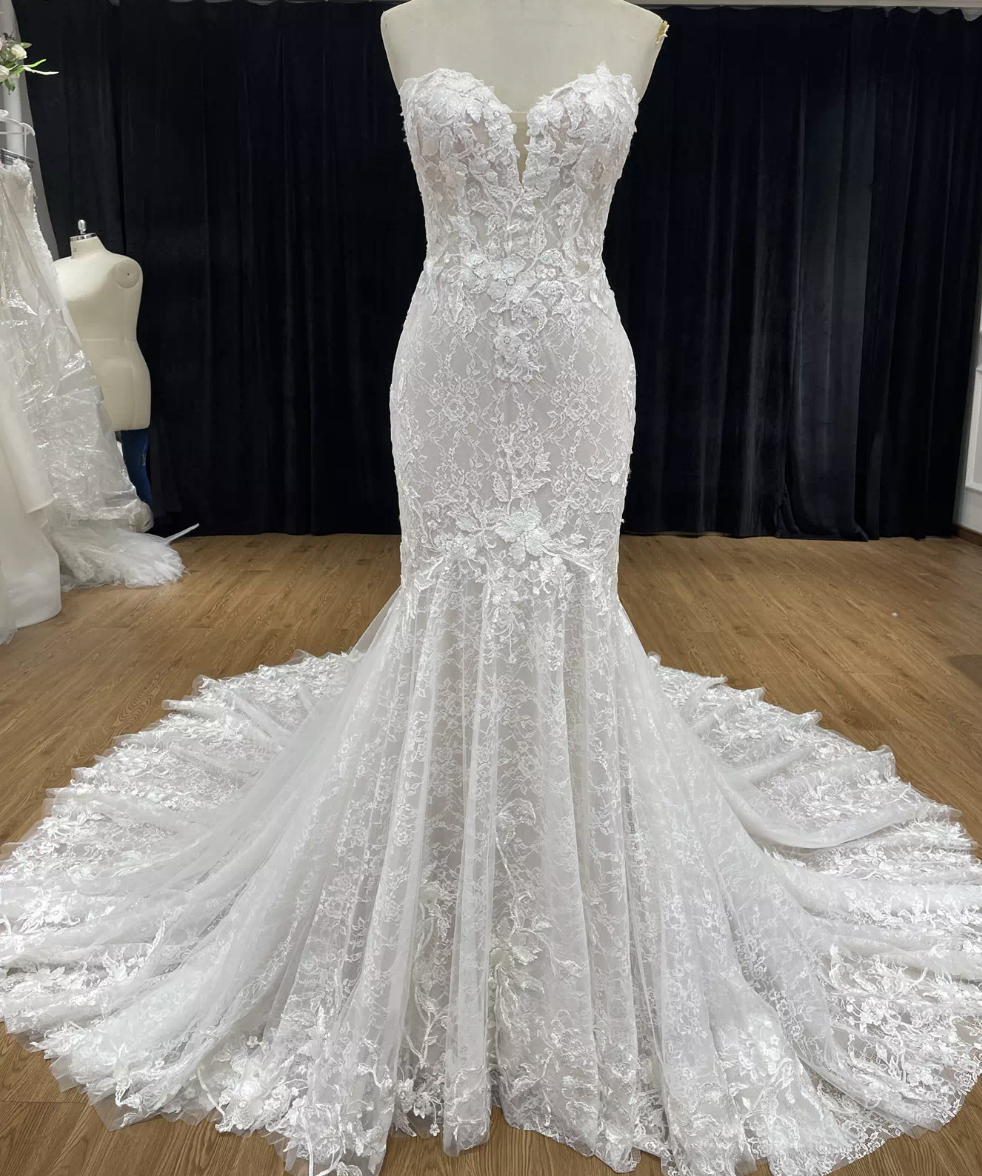
4. Trumpet Wedding Dress: Balanced Elegance with Comfort
The trumpet style is a cousin of the mermaid silhouette, but with a more gradual flare starting around mid-thigh. This allows for greater mobility while still accentuating the waist and hips.
Best For: Hourglass, athletic, or rectangular figures
Ideal Wedding Themes: Chic city weddings, rooftop venues, or art gallery spaces
Why Brides Love It: It gives the hourglass illusion while offering more flexibility and comfort than the mermaid cut.
Extra Tip: Add beading or lace to the flared portion for extra drama as you move down the aisle.

5. Sheath Wedding Dress: Sleek, Modern, and Understated
The sheath or column dress closely follows the natural lines of the body from head to toe. It’s lightweight, elegant, and perfect for brides who prefer clean lines over fluff and volume.
Best For: Tall, slender, or petite brides
Ideal Wedding Themes: Destination, beach, elopement, and modern minimalist weddings
Why Brides Love It: It’s fuss-free and ideal for warm climates or movement-heavy ceremonies. Perfect for brides who love simplicity.
Extra Tip: Pair with a dramatic back or long train to add a wow factor without bulk.
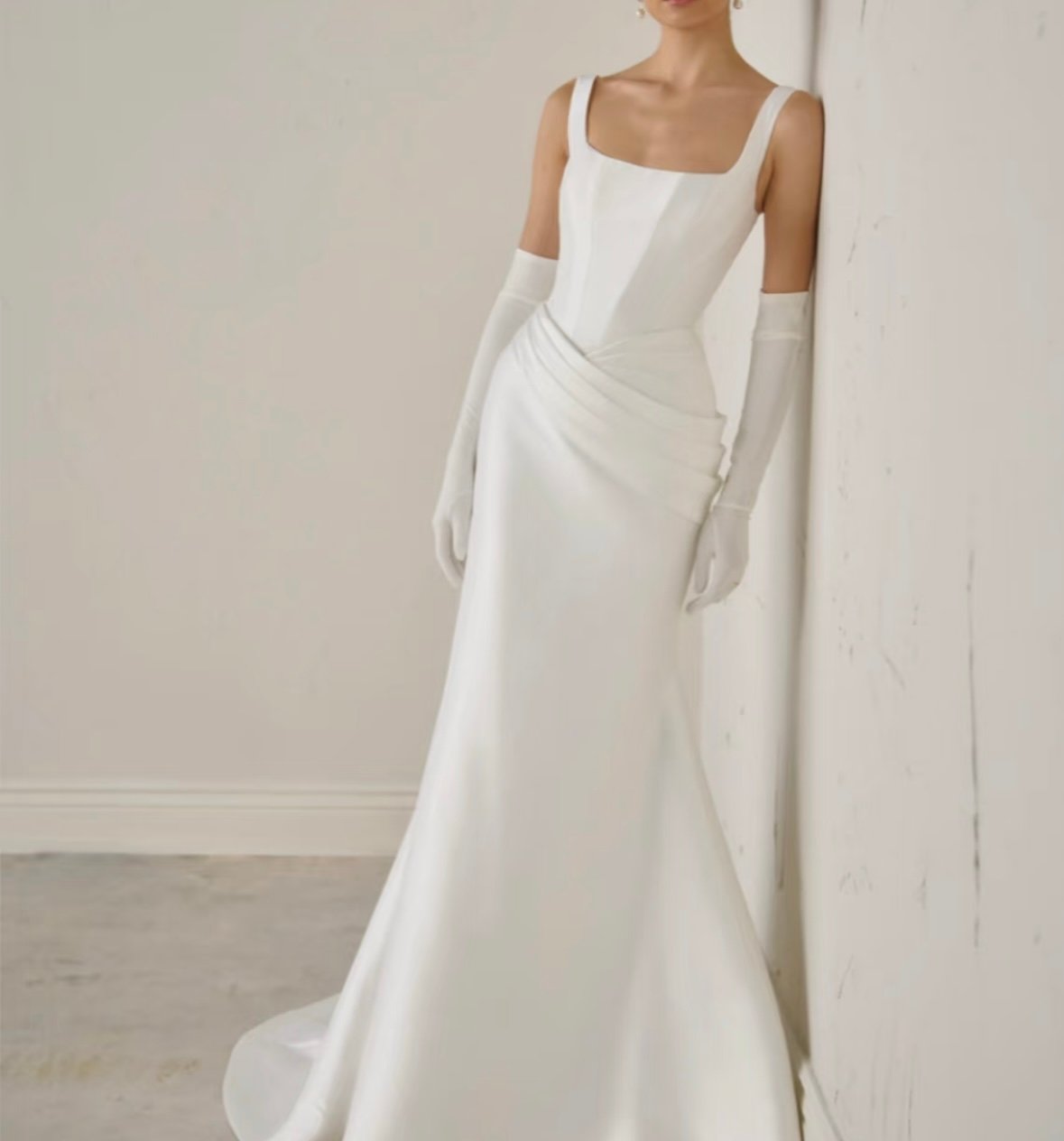
6. High-Low Wedding Dress: Bold and Contemporary
With a front hem that sits above the knees and a back that trails like a traditional gown, the high-low style is trendy, edgy, and playful. It’s perfect for fashion-forward brides.
Best For: Petite or modern brides who love making a statement
Ideal Wedding Themes: City, rooftop, or unconventional weddings
Why Brides Love It: It allows for easy movement and showcases fabulous shoes — ideal for confident, fun-loving brides.
Extra Tip: Add a structured bodice or asymmetrical neckline for extra flair.
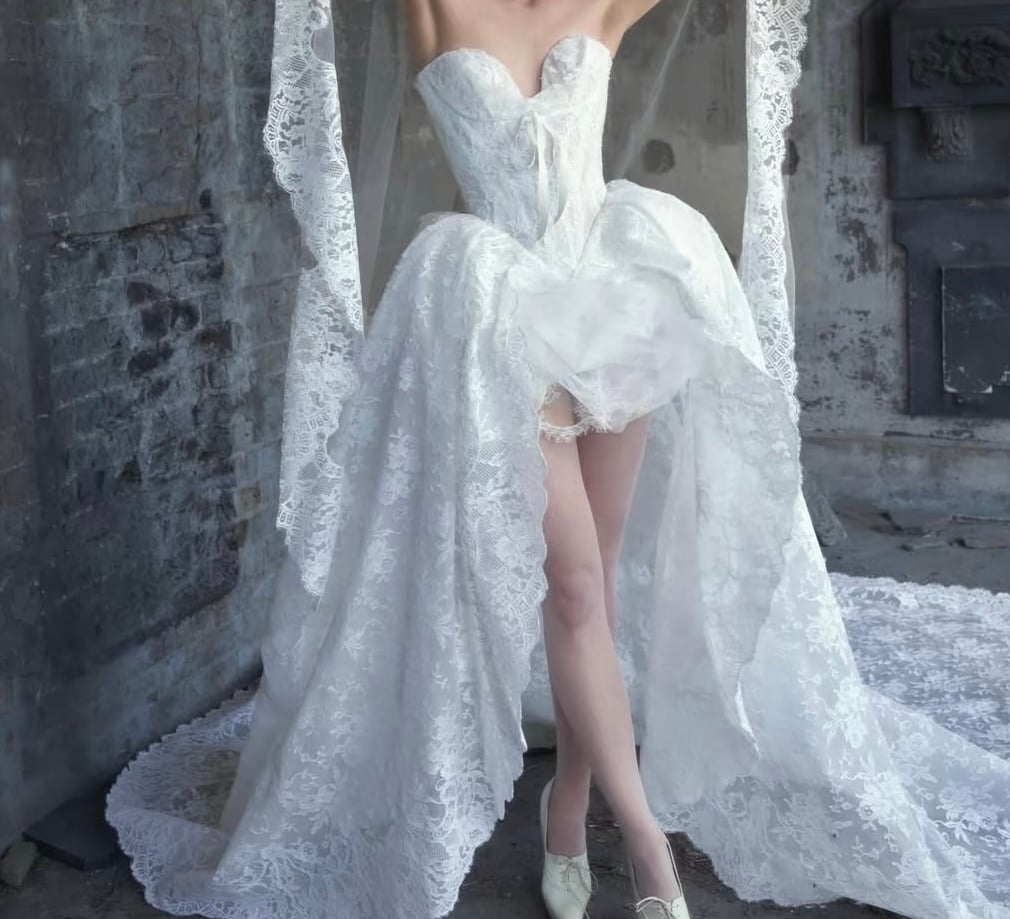
7. Slip Dress: Chic Minimalism at Its Best
Inspired by vintage lingerie, the slip dress is all about effortless beauty. Usually made from silk or satin, it drapes smoothly over the body and offers a minimalist aesthetic.
Best For: Slender, petite, or model-esque brides
Ideal Wedding Themes: Backyard, city hall, rooftop, or tropical elopements
Why Brides Love It: It’s light, simple, yet incredibly sensual — a favourite for intimate and modern ceremonies.
Extra Tip: Add a pearl necklace or a soft veil to enhance the look without taking away its minimal charm.
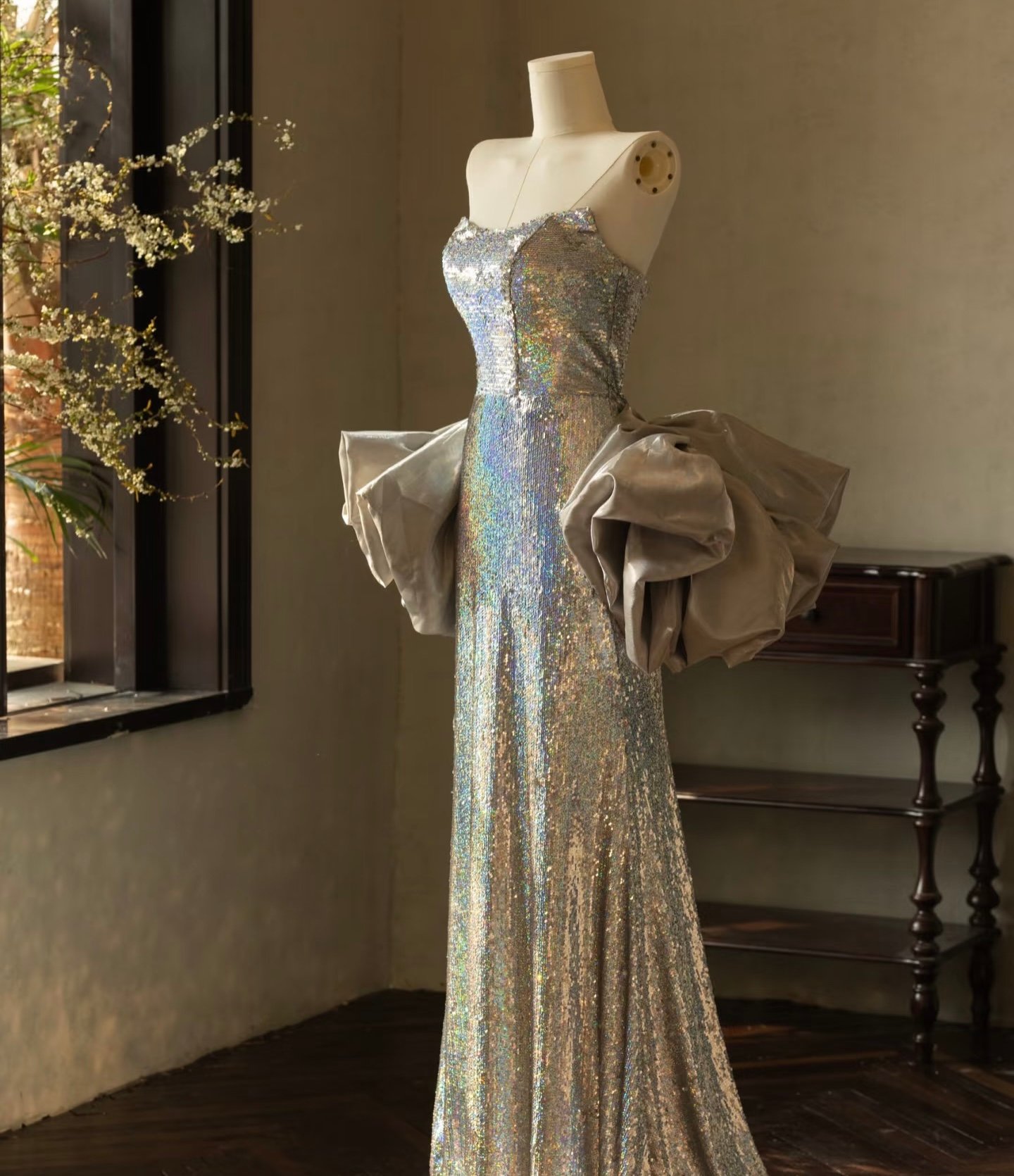
Step 2: Know Your Body Type and What Flatters It
Finding a wedding dress isn’t just about the style — it’s about how that style works with your unique figure. A dress that flatters your natural shape can boost your confidence and help you feel your absolute best when walking down the aisle. Here’s how to identify your body shape and choose silhouettes that enhance your natural beauty.
Hourglass Figure
Traits: Well-balanced bust and hips with a clearly defined waist.
What Works: This balanced figure looks great in almost any silhouette, but especially shines in fitted styles that highlight the waist and curves.
-
Top Dress Picks: Mermaid, trumpet, A-line, fit-and-flare
-
Extra Tips: Look for structured bodices that support the bust, and fabrics that gently hug your curves like stretch satin or mikado. Belts or waist embellishments help draw attention to your best asset — your waistline.
Pear-Shaped Figure
Traits: Narrower shoulders and bust, with wider hips and thighs.
What Works: The key is to balance proportions by adding volume on top or minimizing the lower half.
-
Top Dress Picks: A-line, ball gown
-
Extra Tips: Opt for off-shoulder, illusion necklines, or embellished bodices to draw attention upward. Avoid clingy fabrics on the hips and look for skirts that flow naturally.
Apple-Shaped Figure
Traits: Fuller midsection with a less-defined waist, often with a larger bust and slimmer legs.
What Works: Empire waistlines and structured bodices can help define your shape and create balance.
-
Top Dress Picks: Empire waist, A-line, gowns with V-neck or plunging neckline
-
Extra Tips: Look for corseted designs or ruched bodices to provide structure. Dresses with flowing skirts help divert attention from the midsection.
Petite Frame
Traits: Small stature, shorter height, delicate proportions.
What Works: Dresses that don’t overwhelm your frame — think light fabrics, simple shapes, and higher waistlines to elongate the figure.
-
Top Dress Picks: Sheath, A-line, tea-length, modified trumpet
-
Extra Tips: Avoid large ball gowns or dresses with too much volume, which can make you appear shorter. High waistlines and vertical detailing help create the illusion of height.
Tall and Lean
Traits: Long legs, arms, and a slender frame.
What Works: Taller brides can pull off bold details — dramatic trains, layered skirts, or daring cuts like high slits and low backs.
-
Top Dress Picks: Sheath, ball gown, fit-and-flare, modern silhouettes with striking lines
-
Extra Tips: Embrace your height by going for couture-inspired looks. Halter necks and geometric designs can add bold structure to your silhouette. Don’t be afraid of dramatic veils or capes.
Athletic or Rectangular Figure
Traits: Balanced shoulders and hips, with less definition at the waist.
What Works: The goal is to create curves by accentuating the waist and adding volume where needed.
-
Top Dress Picks: Trumpet, A-line with detailed bodices, peplum styles
-
Extra Tips: Look for dresses with draping, ruching, or asymmetrical designs to create softness. Belts and structured seams can create the illusion of an hourglass figure.
Step 3: Consider the Wedding Venue and Season
Where and when you get married greatly affects your dress choice. A heavy satin ball gown may be perfect for a winter cathedral wedding but unbearable on a tropical beach. Matching your dress to your venue and season ensures comfort and elegance.
Beach Wedding
A beach wedding calls for relaxed, breathable, and lightweight fabrics that can handle wind and sand while keeping you cool.
-
Recommended Fabrics: Chiffon, organza, crepe, light lace
-
Recommended Styles: Sheath, empire waist, or flowy A-line
-
What to Avoid: Heavy beading, long cathedral trains, or thick layers that trap heat
Extra Tip: Opt for shorter hemlines or high-low dresses to keep sand out of your way. Barefoot sandals and floral hairpieces are popular additions.
Church or Cathedral Wedding
Traditional settings usually call for modesty, grandeur, and sophistication. This is where classic silhouettes truly shine.
-
Recommended Fabrics: Satin, mikado, lace
-
Recommended Styles: A-line, ball gown, or modest trumpet styles
-
What to Consider: Long sleeves, higher necklines, or illusion lace coverings for shoulders and arms
Extra Tip: A cathedral-length veil or a lace-trimmed train adds extra drama and reverence to a formal setting.
Garden or Outdoor Wedding
Romantic and whimsical, garden weddings are perfect for soft silhouettes and lightweight fabrics. The goal is effortless elegance with movement and charm.
-
Recommended Fabrics: Tulle, lace, organza, soft silk
-
Recommended Styles: A-line, boho-style sheath, or tea-length
-
Seasonal Advice: Choose breathable fabrics for warm climates; add a capelet or shawl for cooler evenings
Extra Tip: Watch out for long trains that may get caught on grass or uneven paths — consider a bustle or detachable overskirt.
Winter Wedding
A winter celebration invites rich textures, luxurious fabrics, and creative layering to keep you warm without sacrificing style.
-
Recommended Fabrics: Velvet, brocade, thick satin, silk mikado
-
Recommended Styles: Long-sleeved A-line or ball gowns with higher necklines
-
What to Add: Faux fur stoles, capes, gloves, or even embroidered jackets for a wintery fairytale look
Extra Tip: Opt for pearl or crystal embellishments to mimic the sparkle of snow and ice — perfect for magical winter photos.
Step 4: Explore Different Fabrics and Textures
The fabric of your wedding dress doesn’t just affect how it looks — it determines how it moves, feels, and fits. Whether you want a dress that glides like liquid or one that holds a structured shape, choosing the right fabric is essential. Some fabrics are breathable and flowy, ideal for summer, while others are heavy and formal, perfect for winter weddings. Here’s a guide to common wedding dress fabrics and how they impact style and comfort.
Satin
One of the most traditional bridal fabrics, satin has a smooth finish with a beautiful sheen. It’s heavier and ideal for structured silhouettes like ball gowns or trumpet dresses.
-
Best For: Formal or winter weddings
-
Pros: Holds shape well, luxurious finish, supportive
-
Cons: Can feel heavy in hot climates
-
Extra Tip: Satin works beautifully with pleats and draping. It photographs well under soft lighting due to its subtle shine.
Chiffon
Light, sheer, and airy, chiffon flows beautifully and is often used in beach or destination wedding dresses. It adds movement and softness without bulk.
-
Best For: Outdoor or beach weddings
-
Pros: Breathable, flowy, romantic look
-
Cons: Prone to wrinkles and snags
-
Extra Tip: Great for layered skirts, flutter sleeves, or Grecian-style gowns. Use with caution if you need structure — it’s better as an overlay.
Lace
Lace is timeless and elegant. It can be vintage, modern, romantic, or even sexy depending on the design. Some brides go for full lace gowns, while others use it as detail on the bodice or sleeves.
-
Best For: All wedding types, especially romantic, vintage, or garden weddings
-
Pros: Detailed texture, highly customisable, adds visual interest
-
Cons: Can be itchy if unlined, and delicate to clean
-
Extra Tip: Choose chantilly for a delicate look, alençon for vintage feel, or guipure for bold texture. Lace also blends beautifully with illusion necklines and long sleeves.
Tulle
Tulle is the ultimate fabric for dreamy, princess-style dresses. It’s a netting-like material that adds volume and airiness, perfect for layered skirts or veils.
-
Best For: Ball gowns, A-line skirts, veils
-
Pros: Lightweight, creates volume, ethereal feel
-
Cons: Snags easily, may feel itchy if not lined
-
Extra Tip: Soft tulle can create a romantic drape, while stiff tulle adds drama to skirts. Layer multiple shades for depth.
Organza
Similar in look to tulle but crisper and more structured, organza adds shape without heaviness. It has a slightly shiny finish and holds sculptural designs well.
-
Best For: Outdoor weddings, modern and structured silhouettes
-
Pros: Lightweight yet holds shape, elegant shine
-
Cons: Can wrinkle, more rigid than chiffon
-
Extra Tip: Excellent for layered skirts, floral appliqués, or puff sleeves. Use sparingly if you want a softer, fluid look.
Crepe
Crepe has a soft, matte finish with a subtle crinkled texture. It drapes beautifully and clings to the body in a flattering way without being too tight.
-
Best For: Sheath, slip, and minimalist dresses
-
Pros: Sleek, sophisticated, easy to move in
-
Cons: Less suitable for structured designs
-
Extra Tip: Ideal for modern brides or those looking for a chic, understated silhouette. Pairs well with open backs or dramatic sleeves.
Mikado
A heavyweight blend, usually of silk and synthetic fibres, mikado offers structure, sheen, and elegance. It’s perfect for architectural gowns with clean lines.
-
Best For: Cold-weather weddings, formal ceremonies
-
Pros: Holds shape beautifully, resists wrinkles
-
Cons: Heavy in hot weather
-
Extra Tip: Excellent choice for modern minimalist gowns with volume or for classic Audrey Hepburn-style designs.
Velvet
Rich and warm, velvet adds instant drama and luxury. This fabric is rare in bridal wear but unforgettable when used right.
-
Best For: Winter weddings, fashion-forward brides
-
Pros: Soft to the touch, rich colours, warm
-
Cons: Heavy and may not suit all body types
-
Extra Tip: Ideal for winter elopements or moody weddings with jewel tones. Try velvet accents like belts, capes, or even a bold coloured gown.
Final Tips for Choosing the Right Wedding Dress
Now that you’ve explored silhouettes, body types, venues, and fabrics, here are a few extra tips to guide you on your dress journey:
-
Start Early: Give yourself 8–12 months before your wedding to start shopping. Custom gowns or alterations can take time.
-
Set a Budget: Be realistic and factor in alterations, accessories, and veil costs. Let your stylist know your budget upfront.
-
Be Open but Prepared: Try different styles even if you think they won’t suit you. Many brides are surprised by what they fall in love with.
-
Prioritise Comfort: You’ll be wearing the dress for hours. Make sure you can sit, walk, and dance comfortably.
-
Trust Your Gut: You’ll know it’s the right dress when you don’t want to take it off. Don’t let others’ opinions overshadow your instincts.
Summary: How to Choose the Perfect Wedding Dress
Finding your dream wedding dress is one of the most memorable parts of planning your big day. With countless styles, silhouettes, fabrics, and personal preferences to consider, this guide breaks it all down into four essential steps to help you make a confident and informed choice.
1. Understand Wedding Dress Silhouettes
The silhouette defines the overall shape of your dress and how it fits your body. From universally flattering A-lines and fairy-tale ball gowns to curve-hugging mermaids and minimalist slip dresses, each silhouette offers a unique feel and suits different personalities and body types. Knowing these options helps you focus your search and avoid overwhelm.
2. Know Your Body Type and What Flatters It
Your body shape plays a key role in how a dress looks and feels. Whether you’re petite, tall, curvy, athletic, or apple-shaped, there’s a silhouette that will complement your figure beautifully. Understanding which cuts balance or enhance your natural proportions allows you to feel confident and radiant on your wedding day.
3. Match the Dress to Your Venue and Season
The location and time of year of your wedding influence your dress choice more than you might think. Lightweight chiffons are ideal for beach ceremonies, while heavier satins and long sleeves are perfect for winter weddings. Your dress should be not only beautiful but also comfortable and appropriate for the setting.
4. Explore Fabrics and Textures
The fabric affects everything — how the dress drapes, how it moves, and how it feels on your skin. Romantic lace, structured mikado, flowing chiffon, luxurious velvet — each fabric brings a different energy and function. Choosing the right one enhances both comfort and aesthetic.
Final Thought
The perfect wedding dress is one that makes you feel like the best version of yourself. Start early, stay open-minded, and trust your instincts. When you find “the one,” you’ll know — not because it’s trendy or expensive, but because it feels right. And when you feel amazing, you’ll look unforgettable.